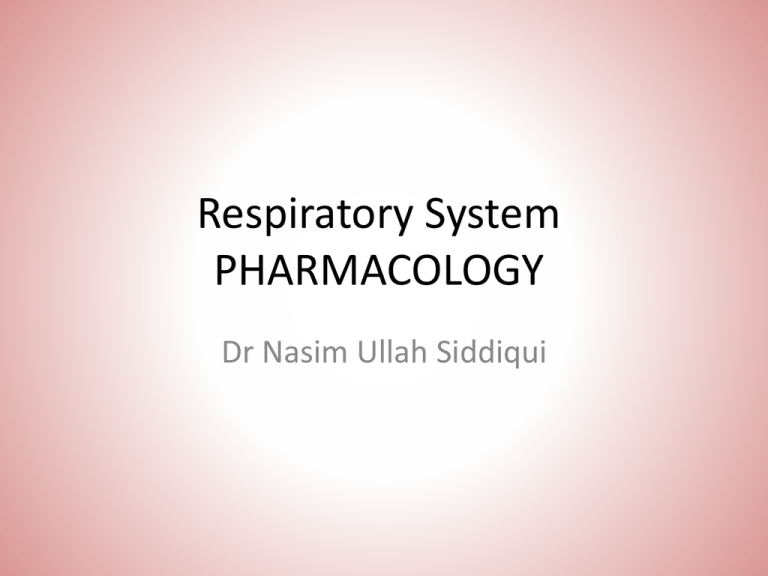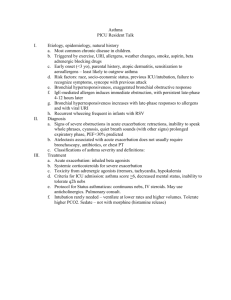Respiratory System
advertisement

Respiratory System PHARMACOLOGY Dr Nasim Ullah Siddiqui FIRST-LINE DRUGS USED TO TREAT ASTHMA Asthma is an inflammatory disease of the airways characterized by episodes of acute bronchoconstriction causing shortness of breath, cough, chest tightness, wheezing, and rapid respiration. A chronic disease with an underlying inflammatory pathophysiology that, if untreated, may incur airway remodeling, resulting in increased severity and incidence of exacerbations . 2 Goals of therapy Reducing impairment: Prevent chronic and troublesome symptoms. Require infrequent use (≤2 days a week) of inhaled short-acting β2 agonist for quick relief of symptoms. Maintain (near) “normal” pulmonary function. Maintain normal activity levels (including exercise and other physical activity and attendance at work or school). 3 Reducing risk Prevent recurrent exacerbations of asthma, and minimize the need for emergency department visits or hospitalizations. Prevent progressive loss of lung function; for children, prevent reduced lung growth. Provide optimal pharmacotherapy with minimal or no adverse effects 4 Role of inflammation in asthma Airflow obstruction in asthma is due to bronchoconstriction that results from contraction of bronchial smooth muscle, inflammation of the bronchial wall, and increased mucous secretion . Asthmatic attacks may be related to recent exposure to allergens or inhaled irritants, leading to bronchial hyperactivity and inflammation of the airway mucosa. 5 Adrenergic agonists Inhaled adrenergic agonists with β2 activity are the drugs of choice for mild asthma—that is, in patients showing only occasional, intermittent symptoms. Direct-acting β2 agonists are potent bronchodilators that relax airway smooth muscle. Quick relief: Most clinically useful β2 agonists have a rapid onset of action (5–30 minutes) and provide relief for 4 to 6 hours. 6 β2 - Adrenergic agonists Used for symptomatic treatment of bronchospasm, providing quick relief of acute bronchoconstriction. β2 Agonists have no anti-inflammatory effects, and they should never be used as the sole therapeutic agents for patients with persistent asthma. Monotherapy with short-acting β2 agonists may be appropriate only for patients identified as having mild intermittent asthma, such as exercise-induced asthma. 7 Adrenergic agonists The direct-acting β2-selective agonists, such as Salbutamol , Terbutaline & Albuterol , offer the advantage of providing maximally attainable bronchodilatation with little of the undesired effect of α or β1 stimulation. The β2 agonists are not catecholamines and, thus, are not inactivated by catechol-O-methyltransferase. Adverse effects: such as tachycardia, hyperglycemia , hypokalemia, and hypomagnesemia are minimized with dosing via inhalation versus systemic routes. 8 Adrenergic agonists Long-term control: Salmeterol and formoterol are long-acting β2 agonists bronchodilators. They are chemical analogs of albuterol but differ by having a lipophilic side chain, increasing the affinity of the drug for the β2-adrenoceptor. Salmeterol and formoterol have a long duration of action, providing bronchodilatation for at least 12 hours. Both salmeterol and formoterol have slower onsets of action and should not be used for quick relief of an acute asthma attack. 9 Adrenergic agonists Long-acting β2 agonists should be prescribed for routine administration. Whereas inhaled corticosteroids remain the longterm control drugs of choice in asthma, longacting β2 agonists are considered to be useful adjunctive therapy for attaining asthma control. Adverse effects of the long-acting β2 agonists are similar to quick-relief β2 agonists. 10 Corticosteroids Inhaled corticosteroids (ICS) are the drugs of first choice in patients with any degree of persistent asthma (mild, moderate, or severe). Severe persistent asthma may require the addition of a short course of oral glucocorticoid treatment. If appropriately prescribed and used, ICS therapy may reduce or eliminate the need for oral glucocorticoids in patients with severe asthma. To be effective in controlling inflammation, glucocorticoids must be taken continuously. 11 Corticosteroids Actions on lung ICS do not directly affect the airway smooth muscle. Instead, ICS therapy directly targets underlying airway inflammation by decreasing the inflammatory cascade (eosinophil's, macrophages, and T lymphocytes), reversing mucosal edema, decreasing the permeability of capillaries, and inhibiting the release of leukotrienes. After several months of regular use, ICS reduce the hyper responsiveness of the airway smooth muscle to a variety of bronchoconstrictor stimuli, such as allergens, irritants, cold air, and exercise. 12 Route of administration Inhalation : The development of ICS has markedly reduced the need for systemic corticosteroid treatment to achieve asthma control. Appropriate inhalation technique is critical to the success of therapy. Metered-dose inhalers have propellants that eject the active medication from the canister. Improper use of a metered-dose inhaler can result in a large fraction (typically 80–90 percent) of inhaled glucocorticoids to be deposited in the mouth, pharynx, and/or swallowed . The 10 to 20 percent of the metered dose of inhaled glucocorticoids that is not swallowed is deposited in the airway. 13 Metered-dose inhaler 14 Nebulizer 15 Route of administration If ICS are inappropriately inhaled, systemic absorption and adverse effects are much more likely. Patients should be instructed to inhale QUICKLY and DEEPLY to optimize drug delivery to the lungs. Even properly administered, corticosteroid deposition on the oral and laryngeal mucosa can cause adverse effects such as oropharyngeal candidiasis and hoarseness. Patient counseling incorporating a rinsing of these tissues via the “swish and spit” method should avoid these adverse events. 16 Route of administration Oral/systemic: Patients with severe exacerbation of asthma (status asthmatics) may require intravenous administration of methylprednisolone or oral prednisone. Once the patient has improved, the dose of drug is gradually reduced, leading to discontinuance in 1 to 2 weeks. In most cases, suppression of the hypothalamic-pituitary axis will not occur during the short course of oral prednisone “burst” typically prescribed for an asthma exacerbation; therefore, dose reduction is not necessary. 17 Route of administration Spacers : A spacer is a large-volume chamber attached to a metered-dose inhaler. Spacers decrease the deposition of drug in the mouth caused by improper inhaler technique . Spacers improve delivery of inhaled glucocorticoids and are advised for virtually all patients, especially children less than 5 years old and elderly patients who may have difficulty coordinating actuation with inhalation. Patients should be counseled about regular washing and/or rinsing of spacers to reduce the risk of bacterial, mold, or mildew growth inducing an asthma attack. 18 Adverse effects: Oral or parenteral glucocorticoids have a variety of potentially serious side effects. Inhaled glucocorticoids, particularly if used with a spacer, have few systemic effects. 19 ALTERNATIVE DRUGS USED TO TREAT ASTHMA These drugs are useful for treatment of moderate to severe allergic asthma in patients who are poorly controlled by conventional therapy or experience adverse effects secondary to high-dose or prolonged corticosteroid treatment. All these drugs are approved for the prophylaxis of asthma but are not effective in situations where immediate bronchodilatation is required. These drugs should be used in conjunction with ICS therapy, not as sole therapies 20 ALTERNATIVE DRUGS USED TO TREAT ASTHMA Leukotriene antagonists Leukotriene (LT) B4 and the cysteinyl leukotrienes, LTC4, LTD4, and LTE4, are products of the 5-lipoxygenase pathway of arachidonic acid metabolism and part of the inflammatory cascade. 5-Lipoxygenase is found in cells of myeloid origin, such as mast cells, basophils, eosinophils, and neutrophils. LTB4 is a potent chemo attractant for neutrophils and eosinophils, whereas the cysteinyl leukotrienes constrict bronchiolar smooth muscle, increase endothelial permeability, and promote mucous secretion. 21 ALTERNATIVE DRUGS USED TO TREAT ASTHMA Zileuton is a selective and specific inhibitor of 5lipoxygenase, preventing the formation of both LTB4 and the cysteinyl leukotrienes. Montelukast are selective, reversible inhibitors of the cysteinyl leukotriene-1 receptor, thereby blocking the effects of cysteinyl leukotrienes . 22 ALTERNATIVE DRUGS USED TO TREAT ASTHMA Modest reductions in the doses of β2-adrenergic agonists and corticosteroids, as well as improved respiratory function, are among the therapeutic benefits. Pharmacokinetics: All these drugs are orally active. Greater than 90 percent of each drug is bound to plasma protein. The drugs are extensively metabolized. Zileuton and its metabolites are excreted in the urine, whereas montelukast and their metabolites undergo 23 ALTERNATIVE DRUGS USED TO TREAT ASTHMA Adverse effects: Elevations in serum hepatic enzymes have occurred with all three agents, requiring periodic monitoring and discontinuation when enzymes exceed three to five times the upper limit of normal. Other effects include headache and dyspepsia. 24 ALTERNATIVE DRUGS USED TO TREAT ASTHMA Cromolyn and Nedocromil Cromolyn and Nedocromil are effective prophylactic anti-inflammatory agents. Not useful in managing an acute asthma attack, because they are not direct bronchodilators. These agents can block the initiation of immediate and delayed asthmatic reactions. 25 ALTERNATIVE DRUGS USED TO TREAT ASTHMA In asthma, Cromolyn is administered either by inhalation of a microfine powder or as an aerosolized solution. Because it is poorly absorbed, only minor adverse effects are associated with it. Pretreatment with Cromolyn blocks allergen- and exercise-induced bronchoconstriction. Cromolyn is also useful in reducing the symptoms of allergic rhinitis. A 4 to 6-week trial is required. 26 ALTERNATIVE DRUGS USED TO TREAT ASTHMA Cholinergic antagonists Anticholinergic agents are generally less effective than β2adrenergic agonists. They block the vagally mediated contraction of airway smooth muscle and mucus secretion. Inhaled ipratropium a quaternary derivative of atropine, is useful in patients who are unable to tolerate adrenergic agonists. Ipratropium is slow in onset and nearly free of side effects. 27 ALTERNATIVE DRUGS USED TO TREAT ASTHMA Theophylline Bronchodilator that relieves airflow obstruction in chronic asthma and decreases its symptoms. Theophylline is well absorbed by the GIT. Theophylline has been largely replaced with β2 agonists and corticosteroids due to a narrow therapeutic window, high side effect profile, and potential for drug interactions. Overdose may cause seizures or potentially fatal arrhythmias. Theophylline is metabolized in the liver 28 ALTERNATIVE DRUGS USED TO TREAT ASTHMA Omalizumab A recombinant DNA–derived monoclonal antibody that selectively binds to human immunoglobulin E (IgE). This leads to decreased binding of IgE to the highaffnity IgE receptor on the surface of mast cells and basophils. Reduction in surface-bound IgE limits the degree of release of mediators of the allergic response. Useful for treatment of moderate to severe allergic asthma in patients who are poorly controlled with conventional therapy. 29 THANK YOU 30 REFERRENCE • LIPPINCOTTS PHARMACOLOGY 31





